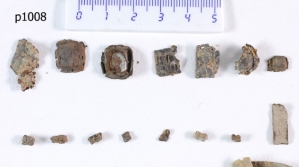
Nine newly located, bean-sized pieces of parchment believed to be part of the now famous Dead Sea Scrolls have been found in Israel.
The bulk of the scrolls were discovered a half century ago, but these nine pieces were just located on a researcher's hunch.
Yonatan Adler, Used a CAT Scan at a nearby hospital in hopes there would be parchment inside the small leather prayer cases he found while searching through the Israel Antiquities Authority's (IAA) storerooms.
He was thrilled to find out he was right.
'I found a number of fragments of tefillin cases from Qumran Cave 4, together with seven rolled-up [phylactery] slips,' Adler told the Times of Israel.
The scrolls went unnoticed for almost 60 years until Adler came across them.
The tiny scrolls were found inside three phylacteries, small leather containers with Biblical verses etched on them, worn during prayers. Until Adler made the find, no one else realized the scrolls were inside the phylacteries.
'Either they didn't realize that these were also scrolls, or they didn't know how to open them,' said the IAA's head of artifact treatment and conservation, Pnina Shor.
The finds are part of at least 24 phylactery scrolls, discovered in the 1940s and 50s, along with the rest of the Dead Sea Scrolls, in a limestone cave in the West Bank's Qumran in Israel. The IAA believes these nine pieces were excavated in 1952.
The scrolls remained locked inside the phylacteries for approximately 2,000 years, until Adler made the discovery.
The IAA has been tasked with the tedious job of unrolling the scrolls without destroying them.
'We're going to do it slowly, but we'll first consult with all of our experts about how to go about this,' said Schor, who would not give details on when the process would begin.
The scrolls are expected to shed new light on the religious practices of the Jewish people between the years of 530 BC and 70 BC. This was known as the Second Temple Period.
Although no "big news" is expected to come out of the tiny pieces of parchment, Adler is still very excited by his find.
"It's not every day you find new scrolls," he said.
Most of what is known as the Dead Sea Scrolls were found inside caves about a mile inland from the northwest shore of the Dead Sea, from which the collection derives its name.







